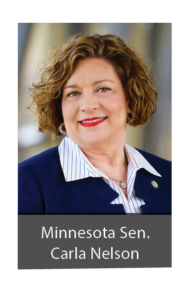Aggravated by the pandemic, a child care ‘crisis’ is disrupting, hurting workforce retention
The child care industry, which was already stressed prior to the COVID-19 pandemic, has faced even more challenges over the past two years — ones that are sending ripples through the economy and the workforce.
“This is not a new issue. Even before the pandemic, we had a silent child care crisis in the United States,” said Heather Sandstrom, senior fellow with the Center on Labor, Human Services, and Population at the Urban Institute, during a December 2021 web event hosted by The Council of State Governments’ Midwestern Legislative Conference.
“It took the pandemic to show the American public just how critical child care is, not only to children and families, but to businesses and to the broader economy,” Sandstrom said.
Large numbers of child care providers permanently shut their doors during the pandemic. According to Child Care Aware, 9 percent of licensed care programs permanently closed between December 2019 and March 2021.
Forty percent of early-childhood education workers lost their jobs during the pandemic, and one in eight haven’t returned to work in the child care field, she said. The U.S. Bureau of Labor Statistics reports that employment in child care services is down 11 percent since February 2020.
Sandstrom said the increasing difficulty in finding affordable, reliable child care is leading some parents to leave the workforce — especially women, who report child care issues as a reason for leaving or not returning to work. Women of color report the largest impact of child care on their ability to work.
“Parents are able to work if they can find and afford child care with reasonable effort,” said Diane Schilder, senior fellow at the Urban Institute. Affordable, reliable child care relates to greater workforce participation, higher retention rates, better attendance, and higher productivity.
“We had a child care crisis before the pandemic,” said Minnesota Sen. Carla Nelson said in the webinar. “And now we also have a workforce crisis.”
 Last year, Nelson was among Minnesota legislators who worked out a package (HF 33) to allocate more than $524 million in federal funds to support early child care and education across the state.
Last year, Nelson was among Minnesota legislators who worked out a package (HF 33) to allocate more than $524 million in federal funds to support early child care and education across the state.
A statewide coalition of child care providers, businesses, advocacy groups and policymakers was assembled to use that money to “address our workforce crisis, our child care crisis, and educational opportunities gap.” Funds were mainly used on facilities and to help build staffing needs through training.
“This was an unprecedented amount of federal funds coming to the state,” said Nelson, who has worked to improve accessibility and quality of child care and early education for many years.”
Minnesota has been a leader in this area, and we continue to do so through the Minnesota model which provides funding from private, federal and state funds,” she said. “And we empower parents to choose which early-child care setting best fits their need and the needs of their child.”
One component that didn’t pass in 2021, but that she hopes to work on this year, is funding for targeted early learning scholarships to “help those who otherwise cannot afford high-quality early learning.”
 Helping lower-income families access quality care is a priority, too, for Wisconsin Sen. LaTonya Johnson, who also presented during the webinar.
Helping lower-income families access quality care is a priority, too, for Wisconsin Sen. LaTonya Johnson, who also presented during the webinar.
“Quality care costs,” said Johnson, who ran an in-home child program for over 10 years. “For so many of our low-income and poor families, quality care is unattainable because of the families’ portion of the co-pay. Even families that receive subsidies cannot afford the difference in cost of care.”
She highlighted a pilot program she initiated in her district to invest in high-quality child care in the largely low-income community. In 2019, the state provided $1.6 million to increase parental subsidies for child care; raise wages of child care workers; provide scholarships for workers looking to increase their education in early childhood education and staff development; and scholarships for infant-toddler credential programs.
“We helped to elevate those day care centers to a higher level,” Johnson said.